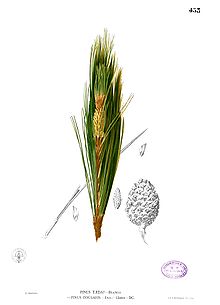| Pinus kesiya | |
|---|---|

| |

| |
| Benguet pine in Benguet, Philippines | |
| Scientific classification | |
| Kingdom: | Plantae |
| Clade: | Tracheophytes |
| Clade: | Gymnospermae |
| Division: | Pinophyta |
| Class: | Pinopsida |
| Order: | Pinales |
| Family: | Pinaceae |
| Genus: | Pinus |
| Subgenus: | P. subg. Pinus |
| Section: | P. sect. Pinus |
| Subsection: | P. subsect. Pinus |
| Species: | P. kesiya
|
| Binomial name | |
| Pinus kesiya | |
| Varieties[2] | |
| |
Pinus kesiya (Khasi pine, Benguet pine or three-needled pine) is one of the most widely distributed pines in Asia. Its range extends south and east from the Khasi Hills in the northeast Indian state of Meghalaya, to northern Thailand, Philippines, Burma, Cambodia, Laos, southernmost China, and Vietnam. It is an important plantation species elsewhere in the world, including in southern Africa and South America.[3][4]
The common name "Khasi pine" is from the Khasi hills in India, and "Benguet pine" is from the landlocked province of Benguet in Luzon, Philippines, where it is the dominant species of the Luzon tropical pine forests (known as saleng in Ilocano[5]). The Benguet pine is sometimes treated as a separate species, Pinus insularis; however, the current opinion is to treat these as conspecific with P. kesiya. The city of Baguio is nicknamed "The City of Pines", as it is noted for large stands of this tree.
- ^ Farjon, A. (2013). "Pinus kesiya". IUCN Red List of Threatened Species. 2013: e.T42372A2975925. doi:10.2305/IUCN.UK.2013-1.RLTS.T42372A2975925.en. Retrieved 19 November 2021.
- ^ Pinus kesiya Royle ex Gordon. Plants of the World Online. Retrieved 12 August 2024.
- ^ Luu, Nguyen Duc To; Philip Ian Thomas (2004). Conifers of Vietnam. Nhà xuất bản Thế giới. pp. 42–43. ISBN 1-872291-64-3. Archived from the original on 2007-05-19.
- ^ "Pinus kesiya". AgroForestryTree Database. International Centre for Research in Agroforestry. Retrieved 17 April 2012.
- ^ Li, Paul Jen-kuei (July 2022). "Some notes on animals and plants for Proto-Austronesian speakers". Language and Linguistics. 語言暨語言學: 266. doi:10.1075/lali.18.2.04li.
